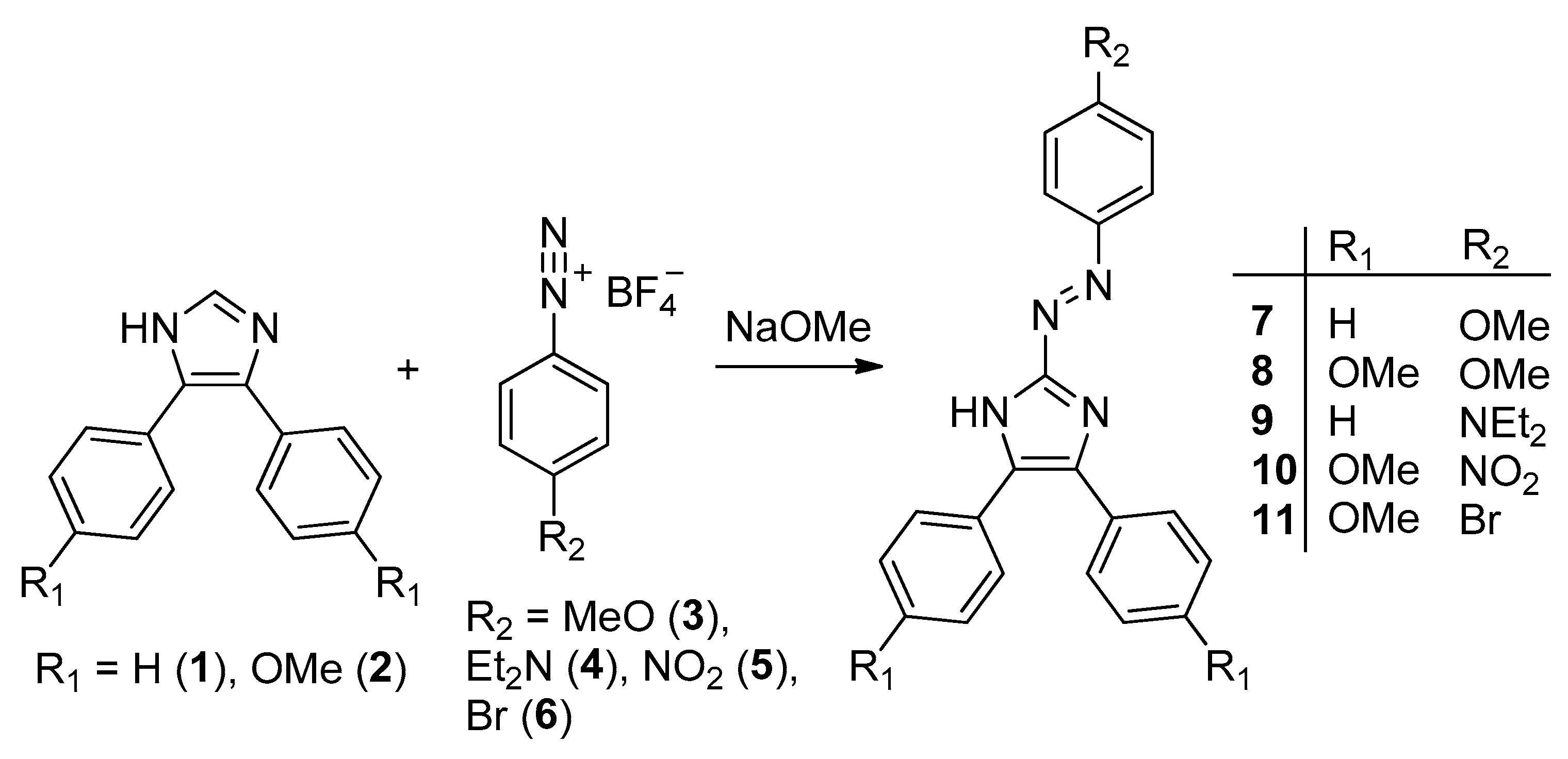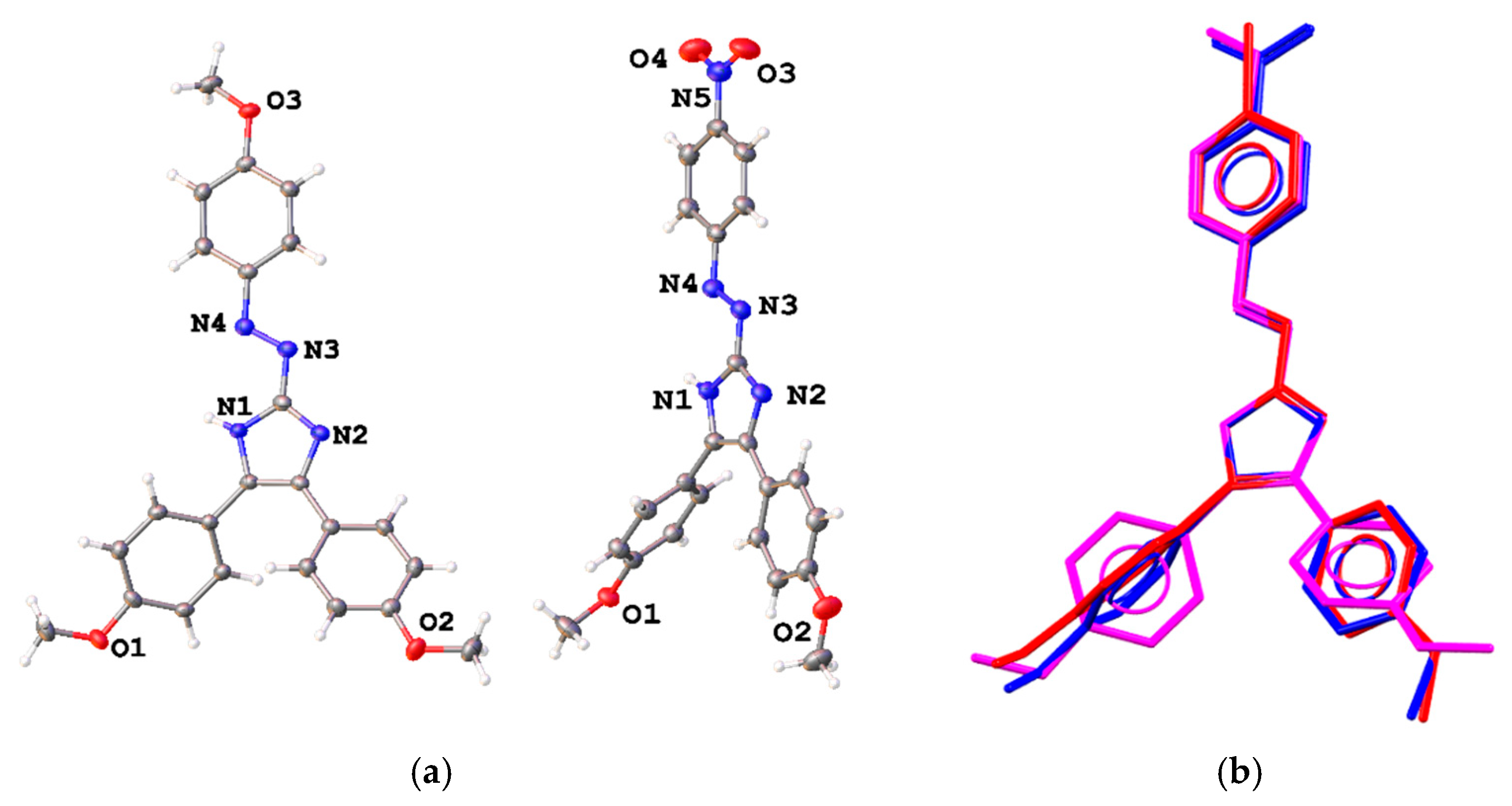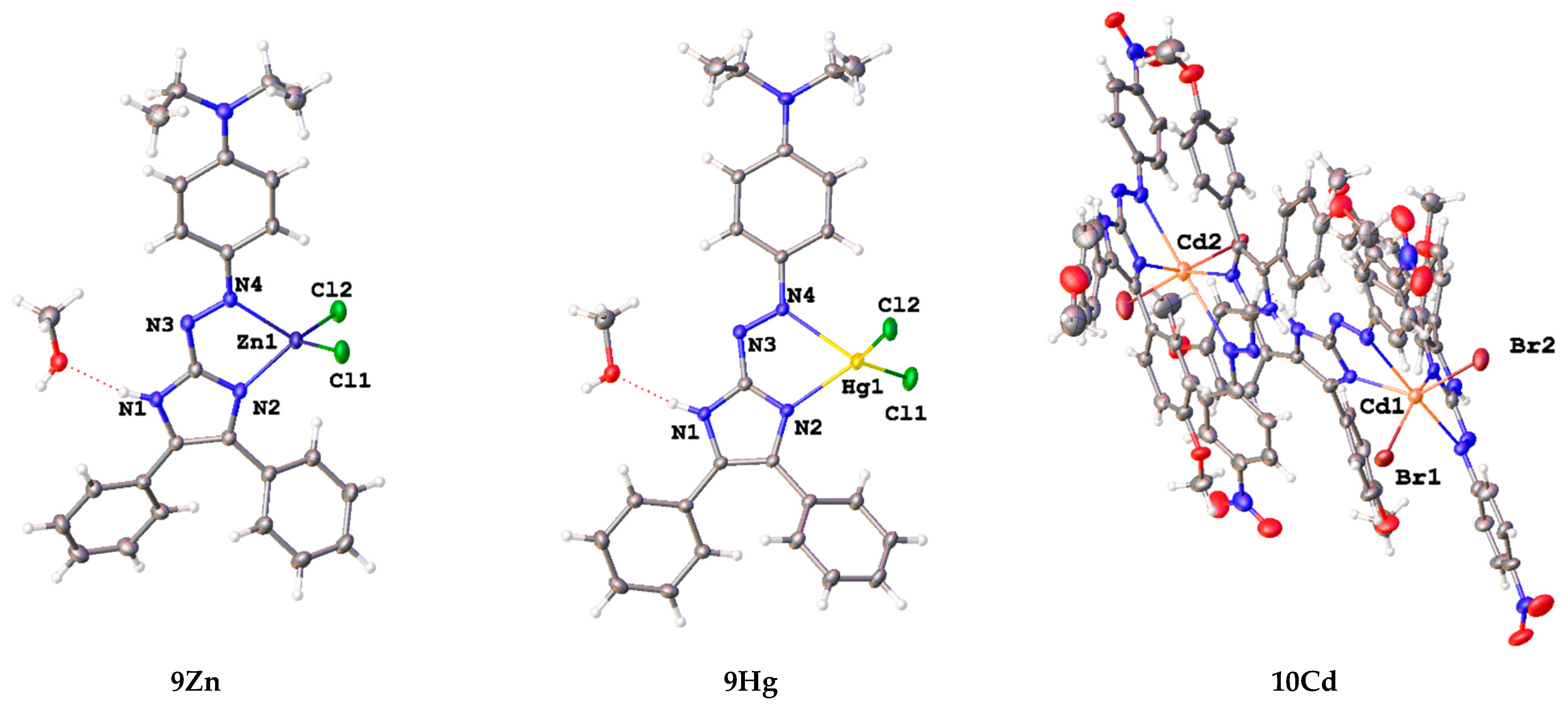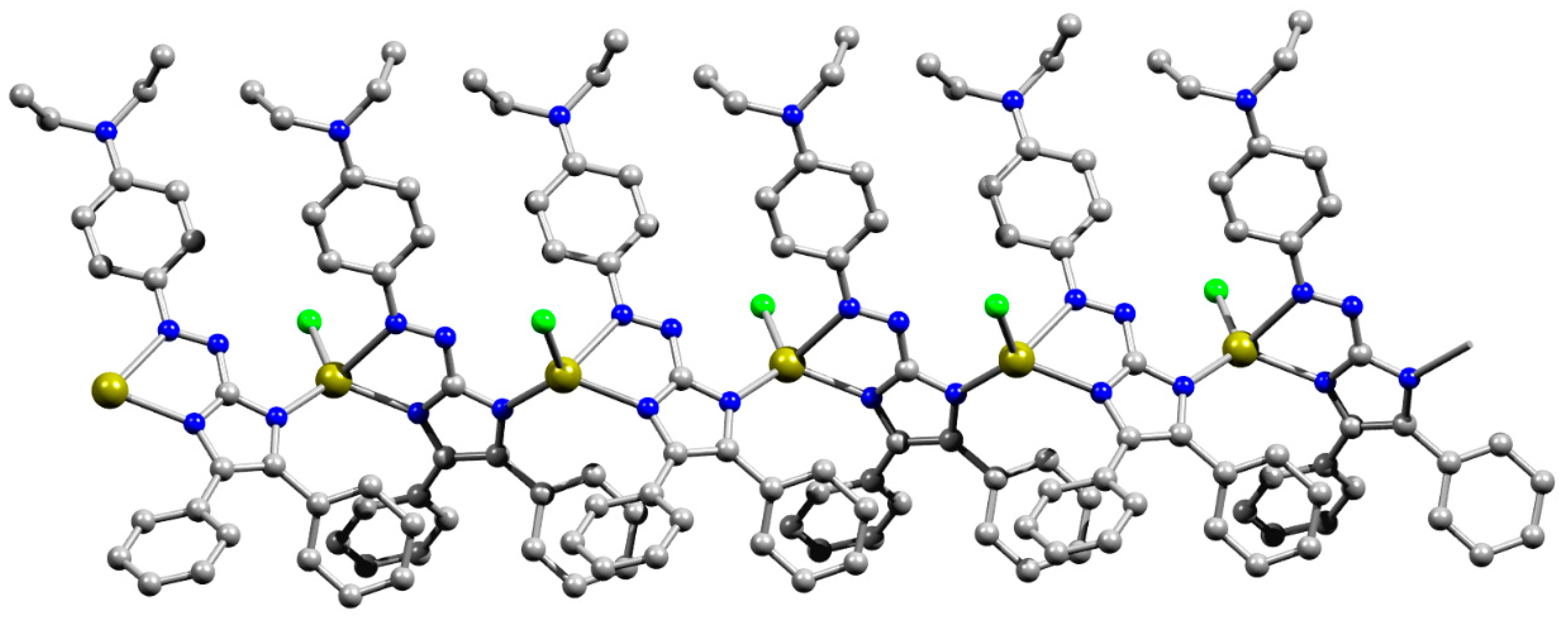Triarylazoimidazole-ZnII, CdII, and HgII Complexes: Structures, Photophysics, and Antibacterial Properties
Abstract
:1. Introduction
2. Materials and Methods
2.1. X-ray Diffraction Studies
2.2. Computational Details
3. Results and Discussion
3.1. Synthesis and Structural Characterization
3.2. Absorption and Emission Profiles
3.3. Antibacterial Tests
3.4. Theoretical Studies of Intermolecular Hydrogen Bonding Interactions N–H···O, O–H···Cl, and N–H···Br in 9Hg, 9Hg’, 9Zn, and 10Cd
4. Conclusions
Supplementary Materials
Author Contributions
Funding
Conflicts of Interest
References
- Otsuki, J.; Suwa, K.; Sarker, K.K.; Sinha, C. Photoisomerization and thermal isomerization of arylazoimidazoles. J. Phys. Chem. A 2007, 111, 1403–1409. [Google Scholar] [CrossRef] [PubMed]
- Astafiev, A.A.; Repina, O.V.; Tupertsev, B.S.; Nazarov, A.A.; Gonchar, M.R.; Vologzhanina, A.V.; Nenajdenko, V.G.; Kritchenkov, A.S.; Khrustalev, V.N.; Nadtochenko, V.N.; et al. Unprecedented Coordination-Induced Bright Red Emission from Group 12 Metal-Bound Triarylazoimidazoles. Molecules 2021, 26, 1739. [Google Scholar] [CrossRef] [PubMed]
- Crespi, S.; Simeth, N.A.; König, B. Heteroaryl azo dyes as molecular photoswitches. Nat. Rev. Chem. 2019, 3, 133–146. [Google Scholar] [CrossRef]
- Sarker, K.K.; Chand, B.G.; Suwa, K.; Cheng, J.; Lu, T.H.; Otsuki, J.; Sinha, C. Structural studies and photochromism of mercury(II)-iodo complexes of (arylazo)imidazoles. Inorg. Chem. 2007, 46, 670–680. [Google Scholar] [CrossRef]
- Liu, Y.; Varava, P.; Fabrizio, A.; Eymann, L.Y.M.; Tskhovrebov, A.G.; Planes, O.M.; Solari, E.; Fadaei-Tirani, F.; Scopelliti, R.; Sienkiewicz, A.; et al. Synthesis of aminyl biradicals by base-induced Csp3–Csp3 coupling of cationic azo dyes. Chem. Sci. 2019, 10, 5719–5724. [Google Scholar] [CrossRef] [Green Version]
- Sarker, K.K.; Sardar, D.; Suwa, K.; Otsuki, J.; Sinha, C. Cadmium (II) complexes of (Arylazo)imidazoles: Synthesis, structure, photochromism, and density functional theory calculation. Inorg. Chem. 2007, 46, 8291–8301. [Google Scholar] [CrossRef]
- Das, D.; Nayak, M.K.; Sinha, C. Chemistry of azoimidazoles. Synthesis, spectral characterization and redox studies of N(1)-benzyl-2-(arylazo)imidazolepalladium(II)chloride. Transit. Met. Chem. 1997, 22, 172–175. [Google Scholar] [CrossRef]
- Schütt, C.; Heitmann, G.; Wendler, T.; Krahwinkel, B.; Herges, R. Design and synthesis of photodissociable ligands based on azoimidazoles for light-driven coordination-induced spin state switching in homogeneous solution. J. Org. Chem. 2016, 81, 1206–1215. [Google Scholar] [CrossRef]
- Tskhovrebov, A.G.; Naested, L.C.E.; Solari, E.; Scopelliti, R.; Severin, K. Synthesis of azoimidazolium dyes with nitrous oxide. Angew. Chem. Int. Ed. 2015, 54, 1289–1292. [Google Scholar] [CrossRef]
- Bhunia, P.; Baruri, B.; Ray, U.; Sinha, C.; Das, S.; Cheng, J.; Lu, T.-H. Azoimidazole Complexes of Manganese (II)-thiocyanate. X-ray Structures of 2-(p-tolylazo)imidazole and Bis-[1-methyl-2-(p-tolylazo)imidazole]-Di-thiocyanato-manganese(II). Transit. Met. Chem. 2006, 31, 310–315. [Google Scholar] [CrossRef]
- Temesgen, A.; Tskhovrebov, A.G.; Vologzhanina, A.V.; Le, T.A.; Khrustalev, V.N. Crystal structure of 2-[(E)-2-(4-bromophenyl)diazen-1-yl]-4,5-bis(4-methoxyphenyl)-1H-imidazole: The first example of a structurally characterized triarylazoimidazole. Acta Crystallogr. Sect. E 2021, 77, 305–308. [Google Scholar] [CrossRef]
- Tskhovrebov, A.G.; Novikov, A.S.; Tupertsev, B.S.; Nazarov, A.A.; Antonets, A.A.; Astafiev, A.A.; Kritchenkov, A.S.; Kubasov, A.S.; Nenajdenko, V.G.; Khrustalev, V.N. Azoimidazole Gold(III) Complexes: Synthesis, Structural Characterization and Self-Assembly in the Solid State. Inorg. Chim. Acta 2021, 522, 120373. [Google Scholar] [CrossRef]
- Sheldrick, G.M. SHELXT—Integrated space-group and crystal-structure determination. Acta Crystallogr. Sect. A Found. Crystallogr. 2015, 71, 3–8. [Google Scholar] [CrossRef] [PubMed] [Green Version]
- Spek, A.L. PLATON SQUEEZE: A tool for the calculation of the disordered solvent contribution to the calculated structure factors. Acta Crystallogr. Sect. C 2015, 71, 9–18. [Google Scholar] [CrossRef] [PubMed] [Green Version]
- Sheldrick, G.M. Crystal structure refinement with SHELXL. Acta Crystallogr. Sect. C Struct. Chem. 2015, 71, 3–8. [Google Scholar] [CrossRef] [PubMed]
- Dolomanov, O.V.; Bourhis, L.J.; Gildea, R.J.; Howard, J.A.K.; Puschmann, H. OLEX2: A complete structure solution, refinement and analysis program. J. Appl. Crystallogr. 2009, 42, 339–341. [Google Scholar] [CrossRef]
- Frisch, M.J.; Trucks, G.W.; Schlegel, H.B.; Scuseria, G.E.; Robb, M.A.; Cheeseman, J.R.; Scalmani, G.; Barone, V.; Mennucci, B.; Petersson, G.A.; et al. Gaussian 09 C.01; Gaussian, Inc.: Wallingford, CT, USA, 2010. [Google Scholar]
- Lu, T.; Chen, F. Multiwfn: A multifunctional wavefunction analyzer. J. Comput. Chem. 2012, 33, 580–592. [Google Scholar] [CrossRef]
- Tskhovrebov, A.G.; Solari, E.; Scopelliti, R.; Severin, K. Reactions of grignard reagents with nitrous oxide. Organometallics 2014, 33, 2405–2408. [Google Scholar] [CrossRef] [Green Version]
- Eymann, L.Y.M.; Tskhovrebov, A.G.; Sienkiewicz, A.; Bila, J.L.; Živković, I.; Rønnow, H.M.; Wodrich, M.D.; Vannay, L.; Corminboeuf, C.; Pattison, P.; et al. Neutral Aminyl Radicals Derived from Azoimidazolium Dyes. J. Am. Chem. Soc. 2016, 138, 15126–15129. [Google Scholar] [CrossRef]
- Nenajdenko, V.G.; Shikhaliyev, N.G.; Maharramov, A.M.; Bagirova, K.N.; Suleymanova, G.T.; Novikov, A.S.; Khrustalev, V.N.; Tskhovrebov, A.G. Halogenated Diazabutadiene Dyes: Synthesis, Structures, Supramolecular Features, and Theoretical Studies. Molecules 2020, 25, 5013. [Google Scholar] [CrossRef]
- Tskhovrebov, A.G.; Vasileva, A.A.; Goddard, R.; Riedel, T.; Dyson, P.J.; Mikhaylov, V.N.; Serebryanskaya, T.V.; Sorokoumov, V.N.; Haukka, M. Palladium(II)-Stabilized Pyridine-2-Diazotates: Synthesis, Structural Characterization, and Cytotoxicity Studies. Inorg. Chem. 2018, 57, 930–934. [Google Scholar] [CrossRef] [PubMed]
- Repina, O.V.; Novikov, A.S.; Khoroshilova, O.V.; Kritchenkov, A.S.; Vasin, A.A.; Tskhovrebov, A.G. Lasagna-like supramolecular polymers derived from the PdII osazone complexes via C(sp2)–H⋯Hal hydrogen bonding. Inorg. Chim. Acta 2020, 502, 119378. [Google Scholar] [CrossRef]
- Shikhaliyev, N.G.; Maharramov, A.M.; Bagirova, K.N.; Suleymanova, G.T.; Tsyrenova, B.D.; Nenajdenko, V.G.; Novikov, A.S.; Khrustalev, V.N.; Tskhovrebov, A.G. Supramolecular organic frameworks derived from bromoaryl-substituted dichlorodiazabutadienes via Cl·Br halogen bonding. Mendeleev Commun. 2021, 31, 191–193. [Google Scholar] [CrossRef]
- Shikhaliyev, N.G.; Maharramov, A.M.; Suleymanova, G.T.; Babazade, A.A.; Nenajdenko, V.G.; Khrustalev, V.N.; Novikov, A.S.; Tskhovrebov, A.G. Arylhydrazones of α-keto esters via methanolysis of dichlorodiazabutadienes: Synthesis and structural study. Mendeleev Commun. 2021, 31, 677–679. [Google Scholar] [CrossRef]
- Tskhovrebov, A.G.; Lingnau, J.B.; Fürstner, A. Gold Difluorocarbenoid Complexes: Spectroscopic and Chemical Profiling. Angew. Chem. Int. Ed. 2019, 58, 8834–8838. [Google Scholar] [CrossRef]
- Tskhovrebov, A.G.; Goddard, R.; Fürstner, A. Two Amphoteric Silver Carbene Clusters. Angew. Chem. Int. Ed. 2018, 57, 8089–8094. [Google Scholar] [CrossRef]
- Bader, R.F.W. A Quantum Theory of Molecular Structure and Its Applications. Chem. Rev. 1991, 91, 893–928. [Google Scholar] [CrossRef]
- Ostrowska, K.; Stadnicka, K.M.; Gryl, M.; Klimas, O.; Brela, M.Z.; Goszczycki, P.; Liberka, M.; Grolik, J.; Węgrzyn, A. Influence of Hydrogen Bonds and π–π Interactions on the Fluorescence of Crystalline (N-Alkylpyridyl)enamino-pyrrolo [2,3-b]quinoxalin-2-one Derivatives. Cryst. Growth Des. 2022, 22, 1571–1582. [Google Scholar] [CrossRef]
- Anitha, C.; Sheela, C.D.; Tharmaraj, P.; Shanmugakala, R. Studies on Synthesis and Spectral Characterization of Some Transition Metal Complexes of Azo-Azomethine Derivative of Diaminomaleonitrile. Int. J. Inorg. Chem. 2013, 2013, 436275. [Google Scholar] [CrossRef]
- Pramanik, A.; Basu, A.; Das, G. Coordination assembly of p-substituted aryl azo imidazole complexes: Influences of electron donating substitution and counter ions. Polyhedron 2010, 29, 1980–1989. [Google Scholar] [CrossRef]
- Aghatabay, N.M.; Neshat, A.; Karabiyik, T.; Somer, M.; Haciu, D.; Dülger, B. Synthesis, characterization and antimicrobial activity of Fe(II), Zn(II), Cd(II) and Hg(II) complexes with 2,6-bis(benzimidazol-2-yl) pyridine ligand. Eur. J. Med. Chem. 2007, 42, 205–213. [Google Scholar] [CrossRef] [PubMed]
- Rasheed, K.; Tariq, M.I.; Munir, C.; Hussain, I.; Siddiqui, H.L. Synthesis, Characterization and Hypoglycemic Activity of Zn(II), Cd(II) and Hg(II) Complexes with Glibenclamide. Chem. Pharm. Bull. 2008, 56, 168–172. [Google Scholar] [CrossRef] [PubMed] [Green Version]
- Espinosa, E.; Molins, E.; Lecomte, C. Hydrogen bond strengths revealed by topological analyses of experimentally observed electron densities. Chem. Phys. Lett. 1998, 285, 170–173. [Google Scholar] [CrossRef]
- Serebryanskaya, T.V.; Novikov, A.S.; Gushchin, P.V.; Haukka, M.; Asfin, R.E.; Tolstoy, P.M.; Kukushkin, V.Y. Identification and H(D)-bond energies of C-H(D) Cl interactions in chloride-haloalkane clusters: A combined X-ray crystallographic, spectroscopic, and theoretical study. Phys. Chem. Chem. Phys. 2016, 18, 14104–14112. [Google Scholar] [CrossRef] [Green Version]
- Tskhovrebov, A.G.; Novikov, A.S.; Odintsova, O.V.; Mikhaylov, V.N.; Sorokoumov, V.N.; Serebryanskaya, T.V.; Starova, G.L. Supramolecular polymers derived from the PtII and PdII schiff base complexes via C(sp2)–H … Hal hydrogen bonding: Combined experimental and theoretical study. J. Organomet. Chem. 2019, 886, 71–75. [Google Scholar] [CrossRef]
- Mikhaylov, V.N.; Sorokoumov, V.N.; Novikov, A.S.; Melnik, M.V.; Tskhovrebov, A.G.; Balova, I.A. Intramolecular hydrogen bonding stabilizes trans-configuration in a mixed carbene/isocyanide PdII complexes. J. Organomet. Chem. 2020, 912, 121174. [Google Scholar] [CrossRef]







| 9Zn | 9Hg | 9Hg’ | 8 | 10 | 10Cd | 11 | |
|---|---|---|---|---|---|---|---|
| M-Hal | 2.212(2)–2.221(1) | 2.3905(9)–2.4210(8) | 2.382(2) | - | - | 2.595(1)–2.640(1) | - |
| M–N1Pz | 2.035(2) | 2.280(2) | 2.156(7)–2.220(6) | - | - | 2.305(5)–2.392(5) | - |
| M–N4 | 2.137(2) | 2.430(2) | 2.430(8) | - | - | 2.556(5)–2.885(6) | - |
| N–M–N | 79.00(7) | 70.08(8) | 69.8(2) | - | - | 62.2(2)–65.8(2) | - |
| Hal–M–Hal | 115.15(5) | 121.99(3) | - | - | 103.8(3)–111.5(4) | - | |
| N1–C3 | 1.386(2) | 1.380(3) | 1.358(10) | 1.3868(1) | 1.35887(6) | 1.348(7)–1.384(8) | 1.372(3) |
| N1=C1 | 1.346(2) | 1.347(3) | 1.321(10) | 1.3595(1) | 1.35986(8) | 1.335(8)–1.373(8) | 1.360(4) |
| C1–N2 | 1.337(2) | 1.384(3) | 1.338(10) | 1.3253(1) | 1.32652(7) | 1.321(8)–1.352(8) | 1.326(3) |
| C1–N3 | 1.378(3) | 1.381(3) | 1.354(10) | 1.3904(1) | 1.38415(7) | 1.352(9)–1.389(8) | 1.392(4) |
| N2–C2 | 1.387(2) | 1.332(3) | 1.356(10) | 1.3806(1) | 1.37085(8) | 1.350(8)–1.395(8) | 1.375(4) |
| C2=C3 | 1.392(3) | 1.395(3) | 1.385(11) | 1.3962(1) | 1.39362(7) | 1.394(9)–1.421(9) | 1.388(4) |
| N3=N4 | 1.296(2) | 1.295(3) | 1.252(9) | 1.2742(1) | 1.26990(7) | 1.271(7)–1.299(8) | 1.274(3) |
| Ar–C | 1.470(3)–1.471(3) | 1.472(3)–1.473(3) | 1.454(10)–1.463(10) | 1.4664(1)–1.4528(1) | 1.46587(8)–1.48591(9) | 1.443(8)–1.485(10) | 1.474(3)–1.477(3) |
| ArvN4 | 1.380(2) | 1.383(3) | 1.386(10) | 1.4224(1) | 1.42510(7) | 1.418(8)–1.437(8) | 1.426(4) |
| Absorption Maximum, nm | εmax, M−1 cm−1 | |
|---|---|---|
| 9 | 493 | 38,300 |
| 10 | 512 | 19,200 |
| 11 | 483 | 18,600 |
| Absorption Maximum, nm | εmax, M−1 cm−1 | Excitation Maximum, nm | Emission Maximum, nm | PL Quantum Yield, % | |
|---|---|---|---|---|---|
| 9Zn | 614 | 31,900 | 626 | 662 | 1.13 |
| 9Cd | 599 | 30,300 | 613 | 653 | 0.60 |
| 9Hg | 517 | 31,300 | 596 | 650 | 0.2 |
| 10Zn | 516 | 77,000 | 621 | 661 | 16.7 |
| 10Cd | 516 | 66,700 | 614 | 662 | 4.7 |
| 10Hg | 517 | 63,100 | 609 | 661 | 2.6 |
| 11Zn | 527 | 21,400 | 590 | 677 | 21.0 |
| 11Cd | 483 | 10,250 | 580 | 668 | 18.8 |
| 11Hg | 503 | 22,400 | 549 | 657 | 0.01 |
| S. aureus | E. coli | |
|---|---|---|
| Inhibition Zone, mm/MIC | ||
| 7 | 20.4 ± 0.1/1.11 | 18.3 ± 0.2/1.13 |
| 8 | 22.3 ± 0.2/0.97 | 19.1 ± 0.3/0.99 |
| 9 | 23.6 ± 0.1/0.81 | 20.1 ± 0.3/0.79 |
| 10 | 22.1 ± 0.3/0.97 | 19.1 ± 0.2/0.99 |
| 11 | 22.6 ± 0.1/0.95 | 19.1 ± 0.2/0.95 |
| 7Zn | 23.8 ± 0.2/0.87 | 19.9 ± 0.2/0.81 |
| 7Cd | 25.2 ± 0.1/0.63 | 18.9 ± 0.3/0.75 |
| 7Hg | 28.7 ± 0.3/0.34 | 20.2 ± 0.2/0.63 |
| 8Zn | 24.5 ± 0.3/0.77 | 19.7 ± 0.1/0.83 |
| 8Cd | 26.9 ± 0.3/0.51 | 20.4 ± 0.2/0.63 |
| 8Hg | 30.1 ± 0.2/0.19 | 21.0 ± 0.2/0.51 |
| 9Zn | 25.0 ± 0.1/0.63 | 20.9 ± 0.2/0.58 |
| 9Cd | 28.5 ± 0.2/0.32 | 21.8 ± 0.3/0.43 |
| 9Hg | 33.4 ± 0.3/0.11 | 22.9 ± 0.1/0.22 |
| 10Zn | 24.8 ± 0.1/0.74 | 19.8 ± 0.4/0.82 |
| 10Cd | 26.5 ± 0.1/0.52 | 20.9 ± 0.1/0.65 |
| 10Hg | 30.4 ± 0.2/0.18 | 21.0 ± 0.3/0.50 |
| 11Zn | 24.4 ± 0.2/0.75 | 19.5 ± 0.1/0.80 |
| 11Cd | 27.3 ± 0.3/0.49 | 20.6 ± 0.1/0.62 |
| 11Hg | 30.0 ± 0.3/0.20 | 21.2 ± 0.3/0.51 |
| Ampicillin | 30.2 ± 0.2/0.12 | ─ |
| Gentamicin | ─ | 22.1 ± 0.2/0.21 |
| Contact | r(A…D) | AHD | ρ(r) | ∇2ρ(r) | λ2 | Hb | V(r) | G(r) | Eint |
|---|---|---|---|---|---|---|---|---|---|
| 9Hg | |||||||||
| N–H···O | 2.747(3) | 167.5 | 0.031 | 0.135 | −0.031 | 0.002 | −0.030 | 0.032 | 9.4 |
| O–H···Cli | 3.129(3) | 163.1 | 0.020 | 0.063 | −0.020 | 0.000 | −0.016 | 0.016 | 5.0 |
| 9Hg’ | |||||||||
| O–H···Cl | 3.124(10) | 162.6 | 0.020 | 0.064 | −0.020 | 0.000 | −0.016 | 0.016 | 5.0 |
| 9Zn | |||||||||
| N–H···O | 2.750(3) | 165.6 | 0.030 | 0.124 | −0.030 | 0.002 | −0.028 | 0.030 | 8.8 |
| Ni–Hi···Oi | 2.750(3) | 165.6 | 0.031 | 0.129 | −0.031 | 0.002 | −0.029 | 0.031 | 9.1 |
| O–H···Cli | 3.104(3) | 165.0 | 0.022 | 0.068 | −0.022 | 0.000 | −0.017 | 0.017 | 5.3 |
| Oi–Hi···Cl | 3.104(3) | 165.0 | 0.020 | 0.064 | −0.020 | 0.000 | −0.016 | 0.016 | 5.0 |
| 10Cd | |||||||||
| N–H···Br | 3.282(5) | 173.7 | 0.020 | 0.061 | −0.020 | 0.000 | −0.015 | 0.015 | 4.7 |
Publisher’s Note: MDPI stays neutral with regard to jurisdictional claims in published maps and institutional affiliations. |
© 2022 by the authors. Licensee MDPI, Basel, Switzerland. This article is an open access article distributed under the terms and conditions of the Creative Commons Attribution (CC BY) license (https://creativecommons.org/licenses/by/4.0/).
Share and Cite
Artemjev, A.A.; Astafiev, A.A.; Vologzhanina, A.V.; Kubasov, A.S.; Burkin, G.M.; Novikov, A.S.; Kritchenkov, A.S.; Kirichuk, A.A.; Tskhovrebov, A.G. Triarylazoimidazole-ZnII, CdII, and HgII Complexes: Structures, Photophysics, and Antibacterial Properties. Crystals 2022, 12, 680. https://doi.org/10.3390/cryst12050680
Artemjev AA, Astafiev AA, Vologzhanina AV, Kubasov AS, Burkin GM, Novikov AS, Kritchenkov AS, Kirichuk AA, Tskhovrebov AG. Triarylazoimidazole-ZnII, CdII, and HgII Complexes: Structures, Photophysics, and Antibacterial Properties. Crystals. 2022; 12(5):680. https://doi.org/10.3390/cryst12050680
Chicago/Turabian StyleArtemjev, Alexey A., Artyom A. Astafiev, Anna V. Vologzhanina, Alexey S. Kubasov, Gleb M. Burkin, Alexander S. Novikov, Andreii S. Kritchenkov, Anatoly A. Kirichuk, and Alexander G. Tskhovrebov. 2022. "Triarylazoimidazole-ZnII, CdII, and HgII Complexes: Structures, Photophysics, and Antibacterial Properties" Crystals 12, no. 5: 680. https://doi.org/10.3390/cryst12050680
APA StyleArtemjev, A. A., Astafiev, A. A., Vologzhanina, A. V., Kubasov, A. S., Burkin, G. M., Novikov, A. S., Kritchenkov, A. S., Kirichuk, A. A., & Tskhovrebov, A. G. (2022). Triarylazoimidazole-ZnII, CdII, and HgII Complexes: Structures, Photophysics, and Antibacterial Properties. Crystals, 12(5), 680. https://doi.org/10.3390/cryst12050680








